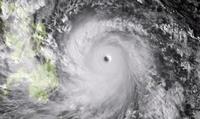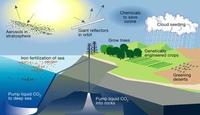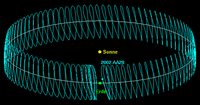-
Massachusetts takes steps to withstand climate change impacts
Governor Deval Patrick of Massachusetts earlier this week unveiled a $50 million plan to help prepare Massachusetts for the challenges climate change poses to energy supplies, public health, transportation, and basic infrastructure in his state. A $40 million grant from the state’s Department of Energy Resources will help cities and towns develop protections around energy services, and $10 million will go toward shoring up critical coastal infrastructure and dam repair.
-
-
Aging natural gas pipelines leak under Washington, D.C. streets
More than 5,893 leaks from aging natural gas pipelines have been found under the streets of Washington, D.C., a team of researchers finds. A dozen of the leaks could have posed explosion risks, the researchers said. Some manholes had methane concentrations as high as 500,000 parts per million of natural gas — about ten times greater than the threshold at which explosions can occur.
-
-
NRC: storing spent nuclear fuel in cooling pools is safe
The nuclear reactors now in service in the United States were built with the assumption that the spent fuel would be removed from nuclear the facilities after a few years, but because the government has failed to provide a centralized place to store the spent fuel, utility companies have had to store an ever-growing quantity of it in spent fuel pools on the grounds of the facilities. Scientists argue that it would be safer to move some of the spent fuel into giant steel and concrete casks, where it can be stored dry, with no reliance on water, pumps, or filters to keep them cool. The nuclear industry and the NRC do not agree.
-
-
The causes of recent Caribbean earthquakes
A 6.4-magnitude earthquake shook Puerto Rico Monday 13 January. It caused some power outages and cracked floors, but no major damage or injuries were reported. The quake, which struck the northern coastal town of Hatillo, is one of the largest to hit the U.S. territory in recent years. This event comes four days after a 5.0-magnitude earthquake rattled Havana, Cuba. Researchers say that the earthquake in Puerto Rico occurred on the North American-Caribbean plate boundary, whereas the earthquake in Cuba happened well inside the North American plate. Although inter-plate earthquakes do occur, often on older faults that are reactivated, they are less common than those that form at plate boundaries.
-
-
Estimating the best time to launch a cyberattack
Of the many tricks used by the world’s greatest military strategists, one usually works well — taking the enemy by surprise. It is an approach that goes back to the horse that brought down Troy. But surprise can only be achieved if you get the timing right. Timing which, researchers at the University of Michigan argue, can be calculated using a mathematical model — at least in the case of cyber-wars. “The question of timing is analogous to the question of when to use a double agent to mislead the enemy, where it may be worth waiting for an important event but waiting too long may mean the double agent has been discovered,” the researchers say.
-
-
Using building “belt” cheaply, quickly to repair of earthquake damage
Four years after the January 2010 earthquake, 145,000 people still remain homeless in Haiti. Researchers developed a cheap and simple technology to repair earthquake damaged buildings to help to reduce these delays by quickly making buildings safe and habitable. The technology involves wrapping metal straps around each floor of the building, which are then tensioned either by hand or using compressed air tools. Unlike other repair methods, it does not require expensive materials or a high level of technical knowledge, making it ideal for use in the developing world.
-
-
Palo Alto Networks acquires Morta Security
Palo Alto Networks has acquired Morta Security, a Silicon Valley-based cybersecurity company operating in stealth mode since 2012. Financial terms of the acquisition were not disclosed. Palo Alto Networks says that the acquisition of Morta Security further strengthens its position as a provider of next-generation enterprise security.Palo Alto Network says that most organizations still rely on legacy point technologies that address only specific types of attacks, or phases of the attack. Because of the singular nature of these technologies, they are ill-equipped to detect and prevent today’s advanced cyberattacks.The company says that to address these challenges, a new approach is required.
-
-
Bringing anthropological insights to bear on cybersecurity
Michael Polanyi (1891-1976), in his book Personal Knowledge, rejected the British Empiricists’ notion that experience can be reduced to sense data, and Alan Turing’s assertion that human minds are reducible to collections of rules. Rather, Polanyi said, it is tacit awareness — he later called it the “structure of tacit knowing”— which connects us, albeit fallibly, with reality. It provides us with the context within which our words and actions have meaning. Princeton’s anthropologist Clifford Geertz (1926-2006), in his The Interpretation of Cultures, built on Polanyi’s argument to say that the task of ethnography is thus to discover and interpret the secondary, or underlying (Polnayi would say “tacit”) meanings of social behavior — the “deep structure” of culture and social life. Cybersecurity experts at Kansas State University, in a 3-year, $700,000 project, take an anthropological approach to cybersecurity: they are examining the unspoken knowledge shared by cybersecurity analysts as a way to develop new automated tools that help analysts strengthen their cyberdefenses.
-
-
2013 natural catastrophes dominated by extreme weather in Europe, Supertyphoon Haiyan

Exceptionally high losses from weather-related catastrophes in Europe and Supertyphoon Haiyan dominated the overall picture of natural catastrophes in 2013. Floods and hailstorms caused double-digit billion-dollar losses in central Europe, and in the Philippines one of the strongest cyclones in history, Supertyphoon Haiyan, resulted in a human catastrophe with over 6,000 fatalities.
-
-
Abandoned mine offers clues about permanent CO2 sequestration
Power plants and other industries are responsible for more than 60 percent of global CO2 emissions, according to the International Energy Agency. Sequestering the CO2 in magnesite deposits would prevent the gas from entering the atmosphere and warming the planet. Stanford University researchers, studyingveins of pure magnesium carbonate, or magnesite — a chalky mineral made of carbon dioxide (CO2) and magnesium – in an abandoned mine in the Red Mountain, propose a novel technique for converting CO2 into solid magnesite, making CO2 sequestration feasible.
-
-
NIST invites comment on RFP to support cybersecurity center of excellence
The National Cybersecurity Center of Excellence (NCCoE) is inviting comments on a Partial Draft Request for Proposals (RFP) for a contractor to operate a Federally Funded Research and Development Center (FFRDC) to support the mission of the NCCoE. The FFRDC will be the first solely dedicated to enhancing the security of the nation’s information systems.
-
-
Relying on geoengineering to reduce climate change unlikely to succeed

Reducing the amount of sunlight reaching the planet’s surface by geoengineering may not undo climate change after all. Researchers used a simple energy balance analysis to explain how the Earth’s water cycle responds differently to heating by sunlight than it does to warming due to a stronger atmospheric greenhouse effect. Further, they show that this difference implies that reflecting sunlight to reduce temperatures may have unwanted effects on the Earth’s rainfall patterns.
-
-
NASA going asteroid hunting

The NASA Asteroid Robotic Retrieval Mission concept involves the capture of an asteroid, and dragging it onto a new trajectory that traps it in the Earth–Moon system where it will be further investigated by astronauts. The current mission design requires the target asteroid to have a diameter of seven to ten meters.
-
-
Scientists predicted size, location of 2012 Costa Rica earthquake
The Nicoya Peninsula in Costa Rica is one of the few places where land sits atop the portion of a subduction zone where the Earth’s greatest earthquakes take place. Costa Rica’s location therefore makes it the perfect spot for learning how large earthquakes rupture. Because earthquakes greater than about magnitude 7.5 have occurred in this region roughly every fifty years, with the previous event striking in 1950, scientists have been preparing for this earthquake through a number of geophysical studies. The most recent study used GPS to map out the area along the fault storing energy for release in a large earthquake. The study accurately forecasted the size and location of the magnitude 7.6 Nicoya earthquake that occurred in 2012 in Costa Rica.
-
-
Curbing climate change requires more attention to livestock
While climate change negotiators struggle to agree on ways to reduce carbon dioxide (CO2) emissions, they have paid inadequate attention to other greenhouse gases associated with livestock. Researchers say that cutting releases of methane and nitrous oxide, two gases that pound-for-pound trap more heat than does CO2, should be considered alongside the challenge of reducing fossil fuel use. Ruminant livestock (cattle, sheep, goats, and buffalo) produce copious amounts of methane in their digestive systems. CO2 is the most abundant greenhouse gas, but the international community could achieve a more rapid reduction in the causes of global warming by lowering methane emissions through a reduction in the number of ruminants, the researchers say, than by cutting CO2 alone.
-
- All
- Regional
- Water
- Biometrics
- Borders/Immig
- Business
- Cybersecurity
- Detection
- Disasters
- Government
- Infrastructure
- International
- Public health
- Public Safety
- Communication interoperabillity
- Emergency services
- Emergency medical services
- Fire
- First response
- IEDs
- Law Enforcement
- Law Enforcement Technology
- Military technology
- Nonlethal weapons
- Nuclear weapons
- Personal protection equipment
- Police
- Notification /alert systems
- Situational awareness
- Weapons systems
- Sci-Tech
- Sector Reports
- Surveillance
- Transportation
Advertising & Marketing: advertise@newswirepubs.com
Editorial: editor@newswirepubs.com
General: info@newswirepubs.com
2010-2011 © News Wire Publications, LLC News Wire Publications, LLC
220 Old Country Road | Suite 200 | Mineola | New York | 11501
Permissions and Policies
Editorial: editor@newswirepubs.com
General: info@newswirepubs.com
2010-2011 © News Wire Publications, LLC News Wire Publications, LLC
220 Old Country Road | Suite 200 | Mineola | New York | 11501
Permissions and Policies
